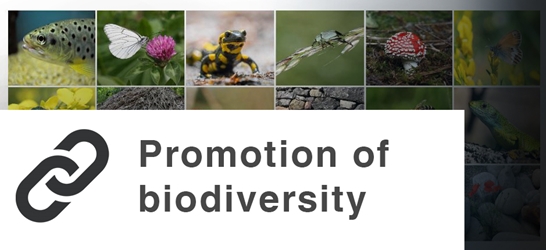 The kingfisher, bee orchid and European pond terrapin are on the red list of threatened species. They are benefiting from habitat enhancement, even in urban areas.
The kingfisher, bee orchid and European pond terrapin are on the red list of threatened species. They are benefiting from habitat enhancement, even in urban areas.
Our interview with the expert on the International Day for Biological Diversity
The decline in biodiversity is at the centre of public attention. The federal popular initiative is not the only reason. At cantonal and communal level, there are discussions about banning mineral gardens and creating living, permeable soil and green spaces, as advocated by the ‘sponge city’ concepts. Companies that own land and property are also increasingly looking for ways to make their space biologically diverse and resilient.
22 may is the United Nations International Day of Biodiversity. On this occasion, we asked our Head of department Environment in German-speaking Switzerland to tell us about Swiss nature and what can be done to protect and preserve it.
Michael Grämiger, biodiversity expert for German-speaking Switzerland
Michael, International Biodiversity Day is a reminder that ‘the protection of species, habitats and biological diversity requires much greater efforts on a global scale’. In Switzerland too?
Yes, of course, in Switzerland too. More than a third of Switzerland's plant, fungal and animal species are currently on ‘red lists’. Many factors contribute to this, such as the deterioration in the quality of habitats, the separation and loss of habitats through urbanisation and infrastructure construction, changes in agriculture (intensification, larger, contiguous farmland, lack of interconnection between habitats, etc.) and the spread of invasive species. Few other industrialised countries have such a high proportion of threatened species.
One has to keep in mind that Switzerland's population has doubled in the last 70 years, from around 4.5 million to 9 million. Only few European countries have experienced a similar development. But at the same time, living conditions have also changed. The surplus population is concentrated exclusively in the Swiss Plateau, a small part of the country. In the mountain regions many communities are fighting against the exodus. The use of mountain pastures, a valuable habitat for many species, is often no longer profitable. At the same time, the pressure exerted on mountain landscapes by leisure activities and tourism has increased. This shows that the causes of the disappearance of species are very varied and represent a major challenge.
How important is biodiversity to us?
It is the prerequisite for human life. Clean air, clean water, and food depend on intact ecosystems. They contribute to our well-being in many ways. To cite a few examples, green spaces can reduce urban temperatures by up to 14°C, the sound of birdsong, green spaces or even a stay in a forest have a positive effect on our psyche, and the economic value of ecosystem services is also immense. The costs of preserving and enhancing ecosystems may be high, but they are infinitesimal compared to the benefits we derive from them.

What are the benefits of, say, municipal projects for supra-regional ecological contexts?
This kind of question is often asked in a broader context, for example when it comes to measures to combat climate change: what's the point of small Switzerland being proactive, while the rest of the world, particularly large countries like China, continue to do business as usual? Why should our small municipality take action to protect biodiversity if our neighbours do nothing? I'm convinced that every step in the right direction, no matter how small, must be taken. Even small community projects offer numerous advantages. First and foremost, and this should be the main motivation, for the local population. These include better quality of life and housing, more resilient living spaces and habitats for beneficial insects, to name but a few. Every square metre counts!
But community projects are also useful at a supra-regional level. They can have a signalling effect on neighbouring municipalities and districts. Bridges can be created for species to strengthen networks of suitable habitats. One of the main problems, particularly in the Central Plateau, is the fragmentation of habitats. Even if they are not part of a larger project, small-scale community projects can still go some way towards improving the connectivity of existing habitats.
What can be done to support biodiversity?
There are many possibilities: from flowering areas, nesting aids, and deadwood structures to unsealing concreted areas or building greening. Not all areas or properties have the same potential. If you want to proceed systematically, you first need assess the situation. Then, measures can be planned, bearing in mind that there are often several parties involved and that the fundamental development objectives must first be clarified. This is followed by professional implementation and monitoring of results. With competent support, these processes run smoothly. Experience of various projects shows that it's very easy to do something good for the environment on your own initiative and contribute to a healthy future worth living. And not just for the future: reclaiming residential areas with intact ecosystems often has an immediate positive effect on quality of life - for all of us!